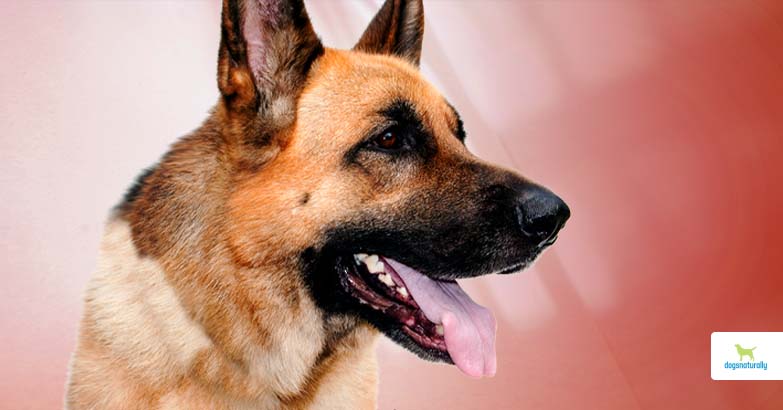There are many reasons for pale gums in dogs but the most important thing to know is that it could be a warning sign of something serious.
So, here’s what you need to know if your dog has pale gums.
What Do Healthy Gums In Dogs Look Like?
First, you want to check your dog’s gums regularly. Some dogs have mottled gums or gums with dark pigment and this is perfectly normal. You should brush your dog’s teeth regularly and check his gums, then you’ll spot when something isn’t quite right.
RELATED: How to brush your dog’s teeth …
Here’s what healthy gums should look like:
- Gums should be pink or a salmon color. They are pink from the tiny blood vessels located under the surface of the gums.
- Healthy gums are also shiny and moist to indicate your dog is well-hydrated.
Signs Of Pale Gums In Dogs
Pale gums will be more whitish than pink, and your dog may be dehydrated. So here are other things you’ll see:
- Gums will range from pale pink to totally white
- Pale gums may feel sticky
- Gums will lose their shiny appearance
You can do the following simple test regularly.
Capillary Refill Test For Dogs
A capillary refill test will tell if your dog is well hydrated and has good blood flow to the gums. Here’s how:
- Lift your dog’s upper lip and gently press your finger to his gums
- Lift your finger and note what happens. The area pressed will be white and once you remove your finger it should return to its normal pink color in 1-2 seconds. That’s known as capillary refill time.
This shows adequate hydration and that blood vessels are refilling quickly. If more than 1-2 seconds pass before the gums turn pink, your dog could be dehydrated … or there could be an underlying health problem.
Are Pale Gums In Dogs Serious?
Pale gums could signal a medical emergency, especially if coupled with collapse … in that case you should get your dog to a vet as soon as possible. This could be a sign of a serious, underlying health condition.
Causes Of Pale Gums In Dogs
Here are some reasons for pale gums in dogs.
Anemia
Anemia is a result of another issue or disease within your dog, and it means there’s a low level of red blood cells. You’ll notice your dog is weak, tired, and may have difficulty breathing. There might be weight loss and an increased heart rate as his system tries to pump more blood.
RELATED: How to recognize and treat anemia in dogs …
Kidney Disease
Kidneys stimulate red blood cell production by producing erythropoietin (EPO) so if there’s kidney disease, EPO production drops down and fewer red blood cells are made, leading to anemia. If your dog has kidney disease yo’ill notice increased thirst, drinking and peeing, reduced appetite, vomiting, diarrhea and weight loss.
RELATED: Natural options for kidney disease in dogs …
Shock, Trauma And Blood Loss
Your dog can go into shock after trauma like a car accident that causes external or internal bleeding. This causes lower blood circulation as the blood vessels constrict. Dogs in shock will have rapid breathing, rapid heart rate and lower body temperature. Shock requires emergency medical treatment.
Traumatic injury or organ disease like a stomach ulcer can cause internal bleeding. Signs of internal bleeding can include sudden collapse, lethargy and difficulty breathing. This is a medical emergency requiring immediate treatment. If there’s been severe blood loss, a transfusion may be necessary to replace lost blood.
Parasites
Parasites like worms feed on your dog’s blood, which deprives him of vital nutrients. Fleas feed on blood so a serious infestation can cause significant blood loss that causes pale gums. You’ll notice intense itching and even hair loss. Roundworms, hookworms and tapeworms are intestinal parasites that affect the digestive system. You’ll also notice weight loss, less energy and reduced appetite.
Bloat
Bloat in dogs is when the stomach fills with gas, becomes distended and can twist upon itself and cut off circulation. This is life-threatening in a very short time and is a veterinary emergency. A dog with bloat will have a distended abdomen, will heave or retch, and may collapse and become very lethargic. He will also be restless and find it difficult to settle and become comfortable. Don’t delay in taking your dog to the vet if you see these symptoms.
Blood Clotting Disorders
If your dog has a blood clotting disorder, he’ll have abnormal bleeding and bruising so you’ll see pale gums. One type of clotting disorder is thrombocytopenia, which is a lack of platelets. Dogs who eat rat poison can have abnormal bleeding and need immediate treatment.
Heart Disease
A dog with heart disease can’t pump blood properly so you may notice pale gums. Some signs of heart disease in dogs include lethargy, reduced appetite, coughing and a distended abdomen filled with fluid.
Heavy Metal Toxicity
Dogs may eat something that contains heavy metals, such as pennies or nails. But it can be more common than that. Feed animals raised alongside highways will breathe in automotive exhaust or eat feed grown alongside highways. When processed for dog food, those heavy metals remain in the food. Heavy metals like zinc can reduce red blood cells and lead to anemia and pale gums. You may see additional symptoms like vomiting, reduced appetite and lethargy.
Cancer
Cancer can affect the bone marrow that produces red blood cells, reducing red blood cell production and leading to anemia and pale gums.
Treatment For Pale Gums In Dogs
There are many reasons for pale gums in dogs, and each will have its own treatment.
Several problems can be related to poor nutrition or nutritional imbalances. By improving your dog’s nutrition with a fresh, whole food diet, you can improve his red blood cell production.
Here are some natural solutions that can help manage pale gums in dogs.
Hydration: This can be as simple as making sure your dog gets lots of water to avoid or eliminate dehydration in both hot and cold weather, especially when he’s very active. You can give your dog bone broth to encourage him to drink … and it provides nutrients as well.
Heavy Metal Detox: If your dog has a high heavy metal burden from exposure to chemicals or toxins, you can help by cleaning up his diet, his surroundings (and yours) and doing a detox. Start with nutritional support for your dog’s liver … and follow the link below for more detail on detoxing your dog.
RELATED: How to detox your dog …
Treat Anemia: You’ll want to find out what’s causing the anemia, but while that happens you can feed your dog some protein- and iron-rich foods like beef liver, salmon and sardines, raw egg yolk or lightly steamed or pureed leafy greens or cruciferous vegetables, and red clover, dandelion root and parsley.
Pale gums in dogs aren’t always serious but they are a warning sign that you don’t want to ignore.












